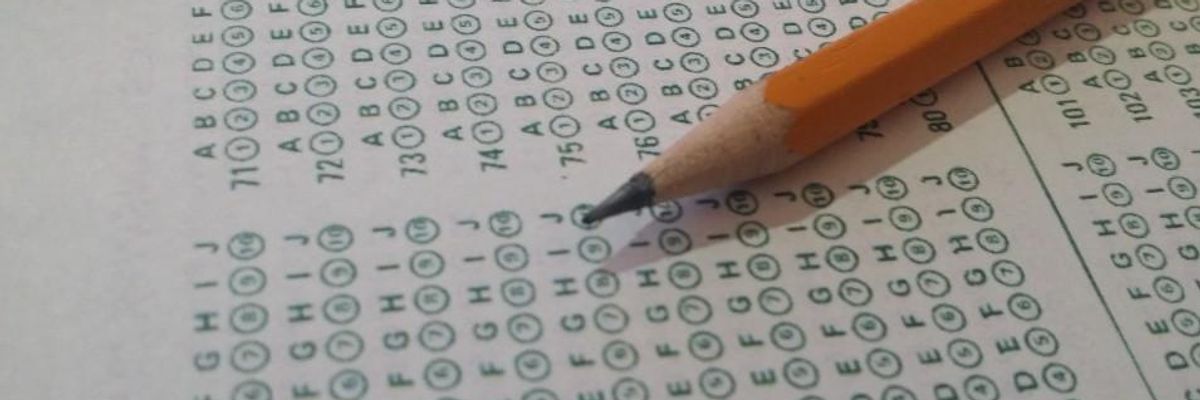
Individual students taking standardized tests in completely non-standardized environments would produce incomparable and totally subjective scores. (Photo: Pixabay/cc)
Even in Non-Pandemic Years, High-Stakes Standardized Tests Don't Accurately and Objectively Measure Teaching and Learning
Given the vast disparities of resources, participation and conditions of education during the pandemic, the results of any high-stakes standardized testing would be invalid—and the act of administering them would be an exercise in futility.
The Biden administration's decision to require schools across the country to administer high-stakes standardized tests this spring caught many parents, students and teachers by surprise. It contradicts President Biden's campaign promises to cut back on testing--and seems to ignore the deep inequities and wild inconsistencies associated with remote schooling over the last year.
What the administration and testing advocates seem to miss is that any data generated by high-stakes standardized testing this spring will be invalid and, therefore, useless. Even in non-pandemic years, high-stakes standardized tests don't accurately and objectively measure teaching and learning.
I am a longtime critic of high-stakes standardized testing for reasons including:
- The racist history of standardized testing in the United States, including a direct lineage to our country's eugenics movement. Over 100 years ago, U.S. psychologists used I.Q. tests to claim that intelligence and other traits were genetically based, and subsequently cast the poor, people of color, and immigrants as biologically less intelligent.
- Our high-stakes test scores today basically mirror the race and class inequalities produced by the racist and classist I.Q. tests created a century ago.
- For decades, research has shown that test scores do not accurately reflect teaching and learning. Rather, they overwhelmingly reflect levels of poverty and other non-school factors such as housing insecurity, food insecurity and access to health care.
- These tests do not work as promised. In the roughly two decades since high-stakes, standardized testing was federally mandated by the 2002 No Child Left Behind Act, there has been virtually no decrease in test-score inequality between major racial and economic student groups, and in some cases, the gaps in scores may have increased.
- High-stakes testing narrows the curriculum to tested subjects, restricts the amount of space for multicultural curricula and culturally relevant teaching, and has resulted in cuts to important time spent at recess and lunch.
These are all concerns I have about high-stakes, standardized testing in a normal year, let alone during a year of pandemic-based remote education.
For testing advocates, one of the central points of these tests is to make "objective" comparisons. They want to use the test data to compare students, teachers and schools to one another. They also want to use the data to compare states and countries, as well as this year's students to last year's students, and so on.
Within the logic of testing, the validity of these comparisons, and arguments about objectivity, rely on standardization. The idea is that you can make valid measurements and comparisons using test scores if different groups of students are given the same test, for the same amount of time, on the same content, under as similar conditions as possible.
That way, according to advocates, we can look at the score of Student A and objectively compare it to Student B, because not only was the content of their testing and learning standardized, but their testing experience was standardized as well. Put differently, the point of standardization is to come as close to an apples-to-apples comparison as possible, as opposed to an apples-to-oranges one.
Standardized comparison is even at the heart of policies using test scores to grade schools and evaluate teachers; both require a stable universe of comparable student standardized test scores to determine whether a school is graded "A" versus an "F," or that a teacher is considered effective or not based on student pass rates.
Schooling during the pandemic has been anything but standardized or objective. While the trauma of the pandemic has been hard on most everyone, economic and health disparities associated with covid-19 have hit poor people and communities of color the hardest.
This means that working-class students and students of color are experiencing pandemic hardships disproportionately: They are more likely to have gotten sick from covid-19, more likely to have lost a relative to covid-19, more likely to have experienced hunger or homelessness due to covid-19, and more likely to be juggling child care and other family responsibilities due to covid-19.
Similarly, we also know that access to technology and reliable Internet service, among other crucial pieces of educational infrastructure during the pandemic, have been inequitable for students of color and poor students.
It is true that the Biden administration has said that the test score data will not be used to discipline or punish low-performing schools, states or districts. However, that is a meaningless gesture.
Individual students taking standardized tests in completely non-standardized environments would produce incomparable and totally subjective scores.
Even if all students and teachers are forced by federal or state decree to return to some amount of face-to-face instruction this spring, there is still no standardized test that will render any valid or objective data for comparison, because the inequitable conditions of our students' lives and learning have been anything but standard.
This school year has been a year like no other. Given the vast disparities of resources, participation and conditions of education during the pandemic, the results of any high-stakes standardized testing would be invalid--and the act of administering them would be an exercise in futility.
An Urgent Message From Our Co-Founder
Dear Common Dreams reader, The U.S. is on a fast track to authoritarianism like nothing I've ever seen. Meanwhile, corporate news outlets are utterly capitulating to Trump, twisting their coverage to avoid drawing his ire while lining up to stuff cash in his pockets. That's why I believe that Common Dreams is doing the best and most consequential reporting that we've ever done. Our small but mighty team is a progressive reporting powerhouse, covering the news every day that the corporate media never will. Our mission has always been simple: To inform. To inspire. And to ignite change for the common good. Now here's the key piece that I want all our readers to understand: None of this would be possible without your financial support. That's not just some fundraising cliche. It's the absolute and literal truth. We don't accept corporate advertising and never will. We don't have a paywall because we don't think people should be blocked from critical news based on their ability to pay. Everything we do is funded by the donations of readers like you. Will you donate now to help power the nonprofit, independent reporting of Common Dreams? Thank you for being a vital member of our community. Together, we can keep independent journalism alive when it’s needed most. - Craig Brown, Co-founder |
The Biden administration's decision to require schools across the country to administer high-stakes standardized tests this spring caught many parents, students and teachers by surprise. It contradicts President Biden's campaign promises to cut back on testing--and seems to ignore the deep inequities and wild inconsistencies associated with remote schooling over the last year.
What the administration and testing advocates seem to miss is that any data generated by high-stakes standardized testing this spring will be invalid and, therefore, useless. Even in non-pandemic years, high-stakes standardized tests don't accurately and objectively measure teaching and learning.
I am a longtime critic of high-stakes standardized testing for reasons including:
- The racist history of standardized testing in the United States, including a direct lineage to our country's eugenics movement. Over 100 years ago, U.S. psychologists used I.Q. tests to claim that intelligence and other traits were genetically based, and subsequently cast the poor, people of color, and immigrants as biologically less intelligent.
- Our high-stakes test scores today basically mirror the race and class inequalities produced by the racist and classist I.Q. tests created a century ago.
- For decades, research has shown that test scores do not accurately reflect teaching and learning. Rather, they overwhelmingly reflect levels of poverty and other non-school factors such as housing insecurity, food insecurity and access to health care.
- These tests do not work as promised. In the roughly two decades since high-stakes, standardized testing was federally mandated by the 2002 No Child Left Behind Act, there has been virtually no decrease in test-score inequality between major racial and economic student groups, and in some cases, the gaps in scores may have increased.
- High-stakes testing narrows the curriculum to tested subjects, restricts the amount of space for multicultural curricula and culturally relevant teaching, and has resulted in cuts to important time spent at recess and lunch.
These are all concerns I have about high-stakes, standardized testing in a normal year, let alone during a year of pandemic-based remote education.
For testing advocates, one of the central points of these tests is to make "objective" comparisons. They want to use the test data to compare students, teachers and schools to one another. They also want to use the data to compare states and countries, as well as this year's students to last year's students, and so on.
Within the logic of testing, the validity of these comparisons, and arguments about objectivity, rely on standardization. The idea is that you can make valid measurements and comparisons using test scores if different groups of students are given the same test, for the same amount of time, on the same content, under as similar conditions as possible.
That way, according to advocates, we can look at the score of Student A and objectively compare it to Student B, because not only was the content of their testing and learning standardized, but their testing experience was standardized as well. Put differently, the point of standardization is to come as close to an apples-to-apples comparison as possible, as opposed to an apples-to-oranges one.
Standardized comparison is even at the heart of policies using test scores to grade schools and evaluate teachers; both require a stable universe of comparable student standardized test scores to determine whether a school is graded "A" versus an "F," or that a teacher is considered effective or not based on student pass rates.
Schooling during the pandemic has been anything but standardized or objective. While the trauma of the pandemic has been hard on most everyone, economic and health disparities associated with covid-19 have hit poor people and communities of color the hardest.
This means that working-class students and students of color are experiencing pandemic hardships disproportionately: They are more likely to have gotten sick from covid-19, more likely to have lost a relative to covid-19, more likely to have experienced hunger or homelessness due to covid-19, and more likely to be juggling child care and other family responsibilities due to covid-19.
Similarly, we also know that access to technology and reliable Internet service, among other crucial pieces of educational infrastructure during the pandemic, have been inequitable for students of color and poor students.
It is true that the Biden administration has said that the test score data will not be used to discipline or punish low-performing schools, states or districts. However, that is a meaningless gesture.
Individual students taking standardized tests in completely non-standardized environments would produce incomparable and totally subjective scores.
Even if all students and teachers are forced by federal or state decree to return to some amount of face-to-face instruction this spring, there is still no standardized test that will render any valid or objective data for comparison, because the inequitable conditions of our students' lives and learning have been anything but standard.
This school year has been a year like no other. Given the vast disparities of resources, participation and conditions of education during the pandemic, the results of any high-stakes standardized testing would be invalid--and the act of administering them would be an exercise in futility.
The Biden administration's decision to require schools across the country to administer high-stakes standardized tests this spring caught many parents, students and teachers by surprise. It contradicts President Biden's campaign promises to cut back on testing--and seems to ignore the deep inequities and wild inconsistencies associated with remote schooling over the last year.
What the administration and testing advocates seem to miss is that any data generated by high-stakes standardized testing this spring will be invalid and, therefore, useless. Even in non-pandemic years, high-stakes standardized tests don't accurately and objectively measure teaching and learning.
I am a longtime critic of high-stakes standardized testing for reasons including:
- The racist history of standardized testing in the United States, including a direct lineage to our country's eugenics movement. Over 100 years ago, U.S. psychologists used I.Q. tests to claim that intelligence and other traits were genetically based, and subsequently cast the poor, people of color, and immigrants as biologically less intelligent.
- Our high-stakes test scores today basically mirror the race and class inequalities produced by the racist and classist I.Q. tests created a century ago.
- For decades, research has shown that test scores do not accurately reflect teaching and learning. Rather, they overwhelmingly reflect levels of poverty and other non-school factors such as housing insecurity, food insecurity and access to health care.
- These tests do not work as promised. In the roughly two decades since high-stakes, standardized testing was federally mandated by the 2002 No Child Left Behind Act, there has been virtually no decrease in test-score inequality between major racial and economic student groups, and in some cases, the gaps in scores may have increased.
- High-stakes testing narrows the curriculum to tested subjects, restricts the amount of space for multicultural curricula and culturally relevant teaching, and has resulted in cuts to important time spent at recess and lunch.
These are all concerns I have about high-stakes, standardized testing in a normal year, let alone during a year of pandemic-based remote education.
For testing advocates, one of the central points of these tests is to make "objective" comparisons. They want to use the test data to compare students, teachers and schools to one another. They also want to use the data to compare states and countries, as well as this year's students to last year's students, and so on.
Within the logic of testing, the validity of these comparisons, and arguments about objectivity, rely on standardization. The idea is that you can make valid measurements and comparisons using test scores if different groups of students are given the same test, for the same amount of time, on the same content, under as similar conditions as possible.
That way, according to advocates, we can look at the score of Student A and objectively compare it to Student B, because not only was the content of their testing and learning standardized, but their testing experience was standardized as well. Put differently, the point of standardization is to come as close to an apples-to-apples comparison as possible, as opposed to an apples-to-oranges one.
Standardized comparison is even at the heart of policies using test scores to grade schools and evaluate teachers; both require a stable universe of comparable student standardized test scores to determine whether a school is graded "A" versus an "F," or that a teacher is considered effective or not based on student pass rates.
Schooling during the pandemic has been anything but standardized or objective. While the trauma of the pandemic has been hard on most everyone, economic and health disparities associated with covid-19 have hit poor people and communities of color the hardest.
This means that working-class students and students of color are experiencing pandemic hardships disproportionately: They are more likely to have gotten sick from covid-19, more likely to have lost a relative to covid-19, more likely to have experienced hunger or homelessness due to covid-19, and more likely to be juggling child care and other family responsibilities due to covid-19.
Similarly, we also know that access to technology and reliable Internet service, among other crucial pieces of educational infrastructure during the pandemic, have been inequitable for students of color and poor students.
It is true that the Biden administration has said that the test score data will not be used to discipline or punish low-performing schools, states or districts. However, that is a meaningless gesture.
Individual students taking standardized tests in completely non-standardized environments would produce incomparable and totally subjective scores.
Even if all students and teachers are forced by federal or state decree to return to some amount of face-to-face instruction this spring, there is still no standardized test that will render any valid or objective data for comparison, because the inequitable conditions of our students' lives and learning have been anything but standard.
This school year has been a year like no other. Given the vast disparities of resources, participation and conditions of education during the pandemic, the results of any high-stakes standardized testing would be invalid--and the act of administering them would be an exercise in futility.

